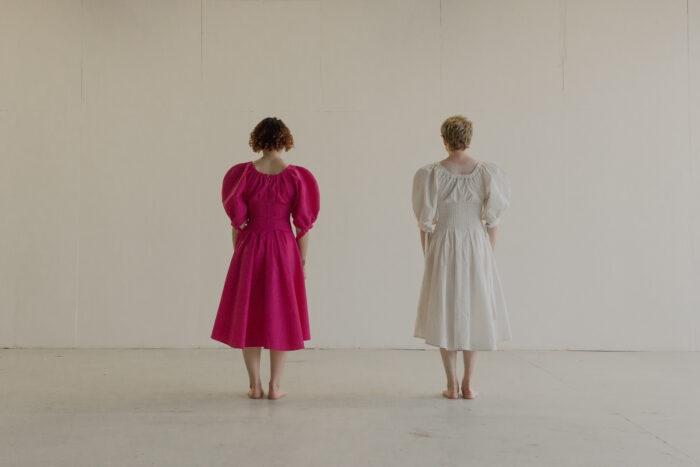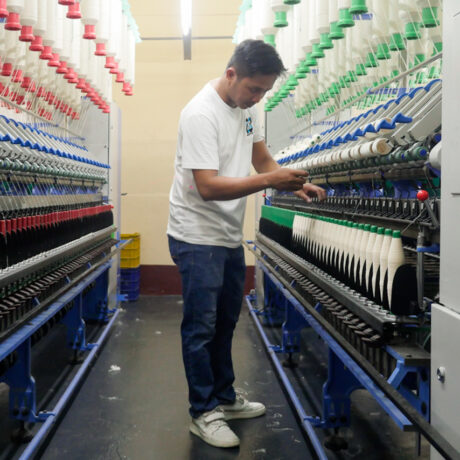Untying the Bounds of Menswear
This article originally appeared in Hajinsky Mag, and has been graciously shared here as we reflect on the ways fabric and materials shape our identity, our environment, and the global fashion supply chain. The images in this article are by Corpora Project duo, Nicci James and Simon Schmidt. Follow along at @hajinskymag and @_corpora.
What is the role of fabrics in teaching us the acceptable norms of gender?
A quintessential British wedding rarely occurs over the fall but this time, I had the privilege to escape the city and enter the Welsh valleys where the golden leaves framed by a crisp blue sky beautifully encircled our friend’s nuptial ceremony. Everything was in place. The bride abounded with lace and taffeta and the groom — as well as most of the male attendees — conscientiously suited in greys, navy and royal blues. Except for me, as a good friend of the groom decided to point out comically, “Oh, nice clutch (bag) you’ve got there”.
The clutch in question was, in fact, my sunglasses case. A somewhat boxy but a well-worn black case that shouldn’t have seemed out of place nor as an anomaly to the ‘perfect picture’, except for the fact that the case was glossed with a patent-like finish.
As a man’s ‘clutch’ welcomed both amusement and comments, I was reminded of the narrow dialogue around the fabrics and textiles that men can hold and wear.
Runways have long included men with sheers, leather, and frills, but in reality, it is utility and functional fabrics that reign in a man’s wardrobe. The ethos of ‘The Dominant Man’, though waning, continues to assert its grip on the cloths of men, upholding the need to resemble strength and ruggedness for the ultimate performance. Silk, satin and the delicate coarseness of embroidery have little place but on the bodies of the protected; the aristocrats and those with hereditary nobilities, or as seen on the female side of a shared wardrobe.
Learned through our skin, these interpretations get sewn into our memory and are worn by our internal self. It is through the physical experience of wearing a garment -— Psychologists call this process Enclothed Cognition — that we build a suite of internal beliefs and representations of the fabrics that come in touch with our body. For example, from experiencing the woven touch or the knitted texture of a garment, we associate the fabric and the clothes to each gender. This communicates with our other senses including our sight (the sheen of silk), our scent (the aroma of leather), and our acoustics (the crunch and crackle of poplin cotton), fine-tuning each gender category in the process.
These internal representations become an illusion of truth that impacts the way we think, the way our body moves, and how we interact with others when we are wrapped in different fabrics.
Our ‘second skin’ then becomes a reality that speaks persona and social order; it dictates how we ought to behave. For many men, it means dressing in a way that speaks masculine prowess. For me, it means I should have felt uncomfortable for holding something that is effeminately patent. In a study that explored the identity of men who wore ‘utility kilts’ for work — a kilt with multiple pockets so that men can carry their workman tools — the canny resemblance of the garment to a skirt was heavily compensated by man-talk. This was done through an over-emphasis that only “real men” can wear a kilt, as well as comments on their hyper-heterosexual sex drive, told with no-holds-barred. As most of the kilt designs were either black, khaki or military, made from the fabric of toughness that can take “a beating”, the men were affirming a masculine identity that the feminine association of a kilt/skirt had taken away. Ostensibly, the touch of fabric on our skin, amongst other gender-defining cues, can make us fervently defend our gender profile yet restrain us back into the traditional sex divide.
With our many years of learning, we may come to ask if fabrics that represent sensuality and fragility could ever offer comfort with feeling and looking like a man; could Bear Grylls or our local (male) bus driver ever wear a satin blouse without feeling conscious or being referred to the sub-group of camp? Fashion Psychology would suggest ‘Yes’, but only with a solution that begins with the re-education of our skin. For men, it would require to be able to move, flex and stretch in the ‘new’ fabrics so that they can start to shake their old internal illusions — the cognitive beliefs that represent the conventional gender ideas.
Through the physical experience of wearing different fabrics, we can begin to learn a more balanced ‘man’ from our senses and interactions.
Fashion — an industry that has the power to inform culture and identity — has long been on the side of breaking the binary gender norms, not least to question the impact of toxic masculinity that has affected many including men themselves; sealing the lips of men who are suffering and in need to call for help. As performed by this issue’s collaborating artists Nicci James and Simon Schmidt, it is the physical exchange between body and fabric that brings a gender-free garment closer to our senses and beliefs, creating a chance for our skin to finally re-learn.
What is your experience — and the memories — that different fabrics bring to you? Share with us via email or Instagram. We would love to collate the way clothes have shaped or challenged your understanding of gender.










